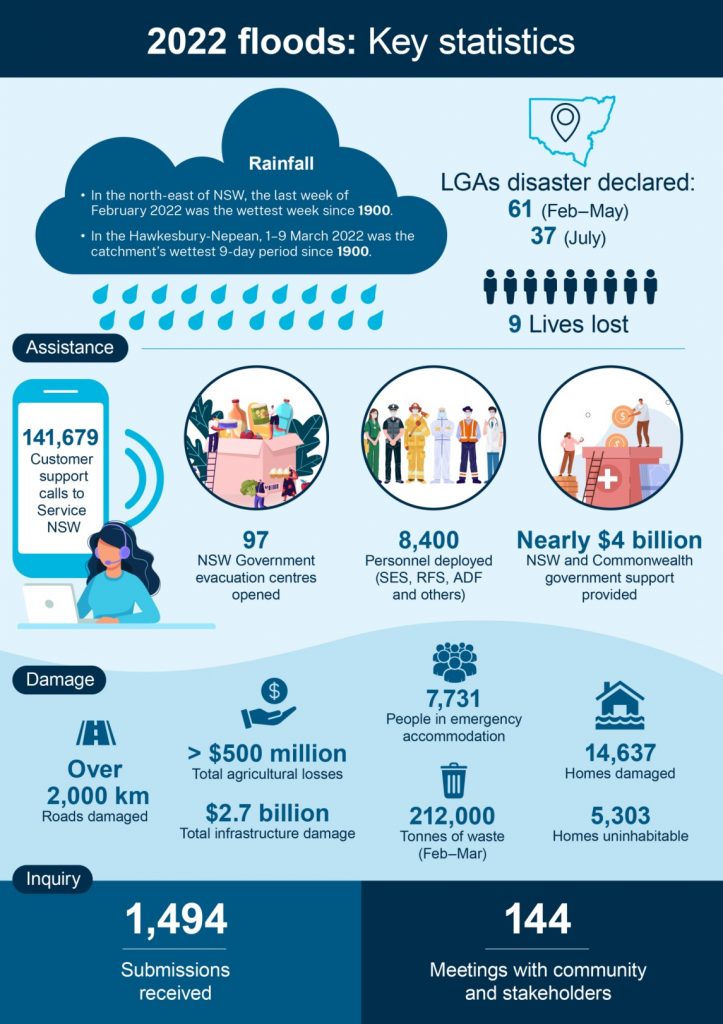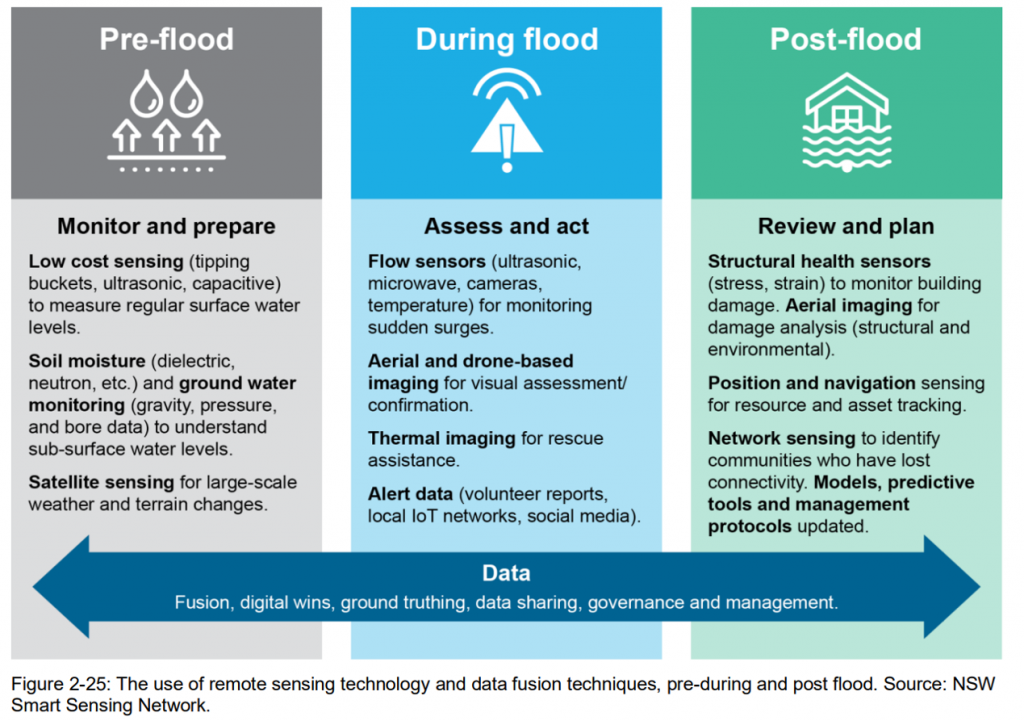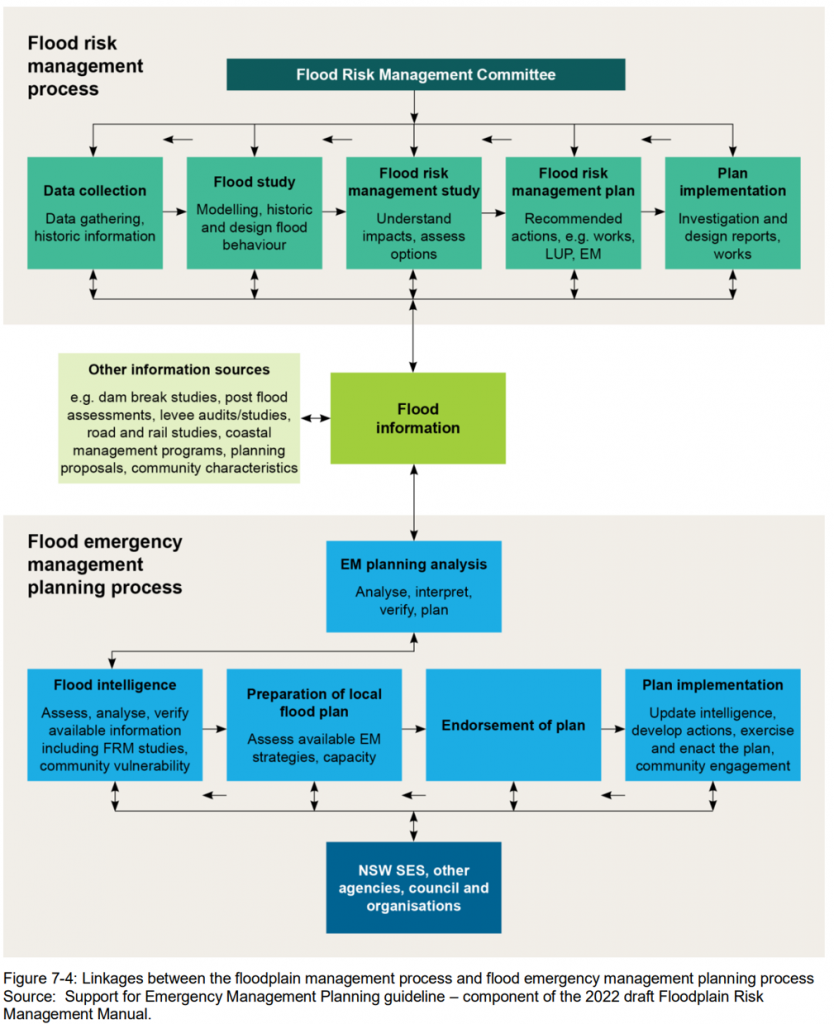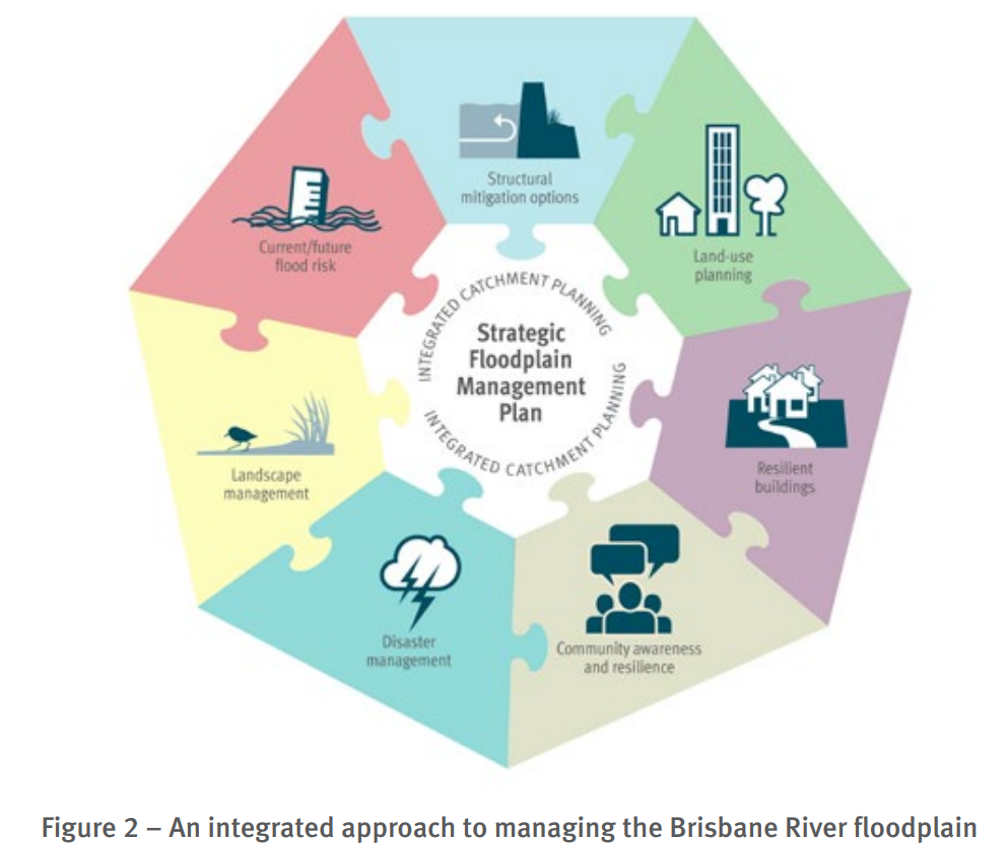In August 2022 the New South Wales Government released a report resulting from an independent inquiry into the the catastrophic floods earlier that year.
In addition to its 28 recommendations the report carries valuable lessons that can help disaster managers everywhere ensure they are helping the preparation for a future event.
My top 25 lessons from the report are below.

Include a First Nations’ perspective.
Use their sense of self-preparedness. Listen to their knowledge. Tap in to indigenous ability to support themselves – and help resource it.
Consider Aboriginal Community Liaison Officers as part of your committees and at your evacuation centres.
Talk to this community about evacuation if it’s a chance, and the trauma this may cause.
P. 127.
Make sure you’ve applied the lessons from the last event.
The report has common themes with previous reports, but says that there is little publicly available evidence if previous recommendations have been implemented. See the Audit Office of NSW report on Addressing public inquiry recommendations – Emergency response agencies‘. If you work within government, well before the next event check who is accountable for previous recommendations and find out what they have done.
Pp. 9-10, 112- 113
Watch the climate drivers and prepare. Watch particularly the SOI, IOD, SAM and MJO.
Saturated catchments and sustained rain are a problem and increase the risk of flooding. The message for disaster managers is to understand the weather in sufficient detail to prepare appropriately beforehand.
- El Nino Southern Oscillation (measured by the Southern Oscillation Index) , La Niña, a phase of ENSO, is associated with cooler surface waters in the Pacific Ocean causing increased rainfall and cloudiness in the western Pacific and usually means above-average winter/spring rainfall for the east and north of Australia
- A negative Indian Ocean Dipole, the difference in sea surface temperatures on either side of the tropical Indian Ocean. The more negative the IOD value, the more likelihood that moisture-laden air will flow towards south-eastern Australia and promote rainfall.
- The Southern Annular Mode. A positive SAM means easterly winds taking moisture from the oceans to the coast instead of the more normal westerly winds of the ‘roaring forties’ and higher latitudes south of Australia
- Madden Julian Oscillation is an eastward moving ‘pulse’ of cloud and rainfall near the equator that typically recurs every 30 to 60 days.
For a layman’s placemat see the Factsheet section of the website.
P53, 64.
Forecasting extreme rainfall over particular catchments is not accurately predictable.
Forecasting extreme rainfall is not accurately predictable in terms of magnitude and landfall location beyond a few days in advance – and even then it may not be accurate enough for communities prone to flooding.
P. 54.
Sensing technologies are important before, during and after a flood.
What are available? Do they get you information as you want them to? Much work has been done in Queensland to integrate sensors in particular gauges. But in general, according to the NSW Flood Inquiry, there are still challenges in drawing the data to provide local, bespoke forecasts and then communicate them reliably during an event.
The message is clear.
- Work towards integration of various agency gauge systems in your local area.
- Tap in to those agencies like Fire Services who may have locally controlled sensors like drones that may be of use.
- Work on the best way of communicating this information to your community.
There’s a great diagram on page 67 and a recommendation about this.

P 71-73
Build redundancy in to your disaster team with committed part-timers.
If you are a single or part time disaster management officer, you’ll be interested in Sutherland Council’s experience and business continuity approach. Establishing a disaster management officer ‘team’ is important – willing volunteers who normally do something else – to build depth and redundancy for long operations.
Sutherland Council case study P. 85.
Resilience and recovery are important. But remember the response phase.
There is a lot of emphasis on resilience and recovery these days, and rightly so. But there is a focus on response in this report – an indication of the importance of getting this phase right also. There is a neat definition of a successful emergency response.
‘A successful response is where no lives are lost, clear information and warnings are provided to empower community action to minimise risk, and emergency services and community work together to minimise both risk and the effect of the disaster’.
We don’t often see success in response defined so clearly. There will be different views, but its a good starting point. Think about what you want it to achieve.
P. 92.
Night time response is expected.
The report revealed a community expectation that rescue services will operate at night. Check the position for yours and reassess this important area and the balance between safety and service delivery. Because it’s likely that the community will expect it.
P. 225.
Go Hard; go Early.
The report talks about the involvement of other agencies, including the ADF. The message is that old disaster management adage ‘Go Hard; Go Early’.
There are down sides to this if nothing happens – people will talk about a waste of resources. But the advantages; in time gained, in opportunity to practice, are very significant.
But remember if this is going to be successful it is essential that all agencies understand the command control and coordination arrangements beforehand.
Pp. 93, 104, 105.
What about livestock flood mounds?
Animals are always a focus in disasters. Cows and horses are a particular challenge. The report draws attention to livestock flood mounds and their construction to keep animals out of water and give somewhere dry to drop fodder. Local governments should provide consistent advice about planning permission aspects.
Pp. 102-103.
Anticipate your communications systems failing, and those that the community rely on – and have a plan.
This point partly goes to the importance of social media and community involvement in response. Are you and your organisation ready to pitch in with what may be a community-member-led effort?
The community always are the first responders. Those managing emergencies should plan to support them, and remember their debriefing and their mental health. And there’s a recommendation about community first responders that gives strength to efforts here.
Pp. 107-108
In Recovery, speed and on-the ground responsiveness is key.
Many agencies including Red Cross and councils have a special place in helping communities to recover. The report highlights local presence, speed of action and funding as critical components to get right. Getting these things in place as part of normal business is an obvious conclusion.
Relying on knowledge of ‘the last flood’ is common, but a dangerous approach.
Plan for the worst is better. People plan for what they know, not what the risk and scale might be. The report has a whole section on understanding flood risk and acting on the threat. And there’s a recommendation about flood education.
Pp. 139, 204-205, 235.
Evacuation is more than getting people out.
Its getting them back in as well – and that needs thinking about. The time of day needs particular considerations. Look at the Rous Council case study for more.
P. 140.
Identify and plan for community infrastructure continuity.
Essential community infrastructure – power, water, telecoms, sewerage and roads – needs comprehensive planning to ensure its survivability or early restoration. If done it will enable the relief and recovery effort in so many ways: powering evacuation centres, enabling ‘000’ calls, allowing fuel deliveries; facilitating information passage and improving command and control. Identify the places that really need it and make a plan.
P154-167.
Waste disposal will overwhelm normal resources – unless you plan for it.
The report cites one affected council where the event resulted in six times the community’s annual contribution to Landfill. Cross-boundary arrangements to distant places may be one answer.
P165-167.
If you have responsibilities for volunteer Emergency Services organisations, look to their culture, corporate maturity and training.
The report contrasts the differences between the NSW Rural Fire Service and the SES. It shows that effort put in to volunteer engagement and training pays dividends – particularly the speed in which new volunteers can become ‘truck ready’. And remember to keep a focus on the local effort.
P188 onwards.
Even if there is a levee, evacuation beforehand is the safe survival strategy.
Infrastructure fails. Levels are designed to protect property – not lives.
P205.
Community engagement needs to be more than just digital – a website and resources.
It needs talking to people in all their diversity and include children and young people. Ensure people in your communities are informed about hazards and develop personal responsibility and capacity to deal with risk, before, during and after a disaster event. A near quote from the report that ties this all this community engagement together.
P234.
Delay in decisions after the event aggravates trauma and hinders recovery and resilience.
Communities within affected communities will recovery at different speeds. The report uses the example of Grantham where ‘fast consultative decision-making took advantage of opportunities’ immediately post flood.
P232-233.
Recovery: build it back better.
The report leans on the experience of a range of authorities to make this point. It include Queensland’s Reconstruction Authority and the UN Sendai Framework. It draws on work for Johnson and Olshansky and their characteristics of successful recovery and reconstruction:
- Managing Money: efficiently, effectively, and equitably.
- Increasing Information Flows: to enhance decision making.
- Supporting Collaboration: genuine collaboration a horizontally among local groups and vertically among different levels of government.
- Balancing Time Constraints: the immediate local needs of recovery and the opportunities for long-term betterment.
More guidance for agencies charged with recovery and reconstruction.
Rather neatly later the report summarises the expectations and guidance for any agency charged with recovery and reconstruction, and quotes Ben Hubbard, the former CEO of the Victorian Bushfire Reconstruction and Recovery Authority. You need three things to do recovery well:
- Mission – your job; not anyone else’s.
- Mandate – you’re allowed to go and get stuff done.
- Resources – you need flexibility of resources, because stuff just happens. Bureaucratic delay is horrendous for recovery.
Learn to live with flood risk differently.
In the light of changing weather events, the Land Use Planning system, flood risk management and flood plain management all need a further look. There’s a whole chapter on this important topic. I won’t go in to detail, as my focus here is on flood emergency planning, response, and recovery. The chapter does emphasise the importance of evacuation planning being incorporated into floodplain planning – and that is an emergency management function.

Again, the QRA has done much work in recent years to draw these strands together in Queensland, particularly in the Brisbane River Strategic Floodplain Management Plan and Flood Studies.

P252-280 onwards
Think fit-for-purpose resilient homes.
Think about and plan for the need for fit-for-purpose resilient homes for those displaced by future floods. But watch that emergency housing doesn’t become de-facto new estates.
The report sets the context of the national housing shortage, COVID, increasing interest rates and a tight rental market. Housing problems after events though are unlikely to go away. It’s a much broader problem that my quick summary line.
P300.
The planning of evacuation routes needs thought and communication.
Repair and reopening of roads in disasters is a major issue for all levels of government. Closing them early may help get them back in use faster. Communication of road closures is critical to allow safe evacuation. The report advocates cross referencing of information and effort to ensure accuracy so that residents can plan for their own evacuation. In the longer term, route capacity and resilient roads should figure in planning and reconstruction.
P309.